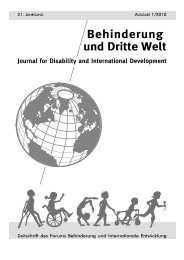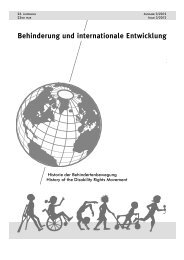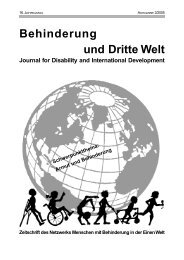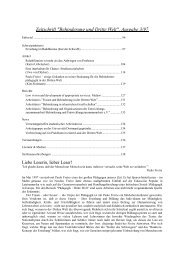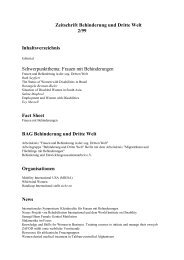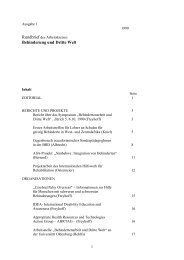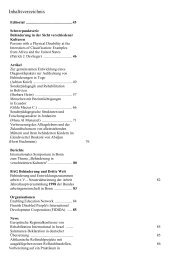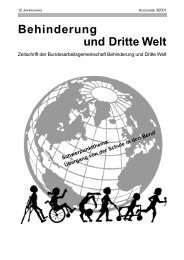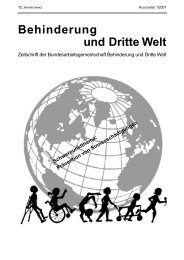Zeitschrift Behinderung und Dritte Welt
Zeitschrift Behinderung und Dritte Welt
Zeitschrift Behinderung und Dritte Welt
You also want an ePaper? Increase the reach of your titles
YUMPU automatically turns print PDFs into web optimized ePapers that Google loves.
S CHWERPUNKTTHEMAto a full <strong>und</strong>erstanding of deaf women abuse.Yet despite this, she recalls that a single effortby one of the leading women’s organizations,the Women’s Education Development Productivityand Research Organization, to provide genderand development training to six deaf officersfrom 1998 to 2001 brought awareness tomember deaf organizations in the major islandsof Luzon, Visayas and Mindanao. Furthermore,she believes that this pioneering effort laid thefo<strong>und</strong>ation for bringing Deaf women into themajority of leadership positions up to the presenttime. In the past few years, she credits thepresence of deaf volunteers of Voluntary ServiceOverseas – Philippines and the networkingefforts by the Phil. Deaf Resource Center tohave exerted the greatest influence in bringingdeaf women leaders into the mainstream. Shebelieves that the concerns of deaf women areimportant to both the disability and women’ssectors and barriers to information should bedismantled through sign language interpreting.Both sectors should also strive to <strong>und</strong>erstandthe culture of the deaf in order to foster lastingbonds (Corpuz 2009).Fo<strong>und</strong>ing member and long-time leader ofthe Fil. Deaf Women’s Health and Crisis Center,Jeniffer Mendoza, sees some awareness in boththe disability and women's sectors about theproblem of deaf abuse. But she laments thatsociety as a whole has not yet fully acceptedthe existence of this problem. She recognizeshowever, the efforts of the organization Womenwith Disabilities Leap to Social Progress toreach out to them in recent years. She also citescollaborative endeavours with the mainstreamin the past five years including the University ofthe Philippines College of Social Work for theParticipatory Video project; the Phil. Deaf ResourceCenter for women’s health lectures;workshops by leading women’s nongovernmentalorganizations Women’s Crisis Center andWomen’s Legal Education, Advocacy and Defensefor crisis intervention and legal informationon sexual harassment; and orientation providedby the Government Department of SocialWelfare and Development, for shelter and fostercare concerns. For full participation in boththe disability and women’s sectors, she recommendscomprehensive teaching of sign languagecoupled with inclusion of deaf women infront-line women’s desks throughout the country,and the training of female deaf relay interpretersas well as facilitators/trainers. She alsoemphasizes priority areas for livelihood developmentfor deaf women to attain economic independence,and the continuing use of media(e.g., participatory video) to bring greater visibilityto deaf women (Mendoza 2009).Advocacy Milestones and MultidimensionalRelationshipsIntegrating selected advocacy milestones forand by deaf women described above, with theassociated dimensions of relationships revealTable 2.All these relationship dimensions of deafwomen have been affected by advocacy milestonesin the past decade. It is noticeable however,that more of these accomplishments dealtwith other women: first, with the hearing majorityof Filipinas who have no disability, andsecond, with other deaf women. Little interactionand impact was seen with women with disability,and worse, with nonsigning deaf Filipinas.With the male gender, the same patternwas seen with the greatest impact first on thehearing majority of Filipino men, and second,on deaf men.Looking at the dozen milestones enumeratedhere, the top three with the broadest impactappeared to be: Participation in the PhilippineLinguistics Congresses, the proposal to the SupremeCourt, and the The Asia Fo<strong>und</strong>ation/U.S.Agency for International Development legal accessproject outcome. Different reasons accountedfor this. The congresses, though heldonly in 2006 and 2008, had 200-300 participantsfrom provinces all over the country.Granting that their interests were in (spokenlanguage) linguistics, they quickly appreciatedhowever, the language issues at stake. The increasedawareness about the deaf and signlanguage among these numerous hearing Filipinossent out a far-reaching contingent of enlightenedindividuals in the different islands.On the other hand, approval of the AmendatoryMemorandum by the Supreme Court willaffect h<strong>und</strong>reds of trial courts and set importantprecedents in the pursuit of justice. The importanceof institutionalization of advocacythrough policy is clearly seen here. Thirdly, thepublished compendium and the national seminarof the The Asia Fo<strong>und</strong>ation/U.S. Agency forInternational Development flagship projectwere highly significant avenues for informationdissemination.The observation that about half of theseenumerated milestones resulted in an internalimpact within the community of deaf womenseems to imply that full participation is both anessential part of empowerment as well as a fuelingresult of advocacy. Thus, strengtheningties within this group is imperative.Filipinas who are deaf (non-signers) are severaltimes more vulnerable to abuse than deaf10 <strong>Zeitschrift</strong> <strong>Behinderung</strong> <strong>und</strong> <strong>Dritte</strong> <strong>Welt</strong> 3/2009



